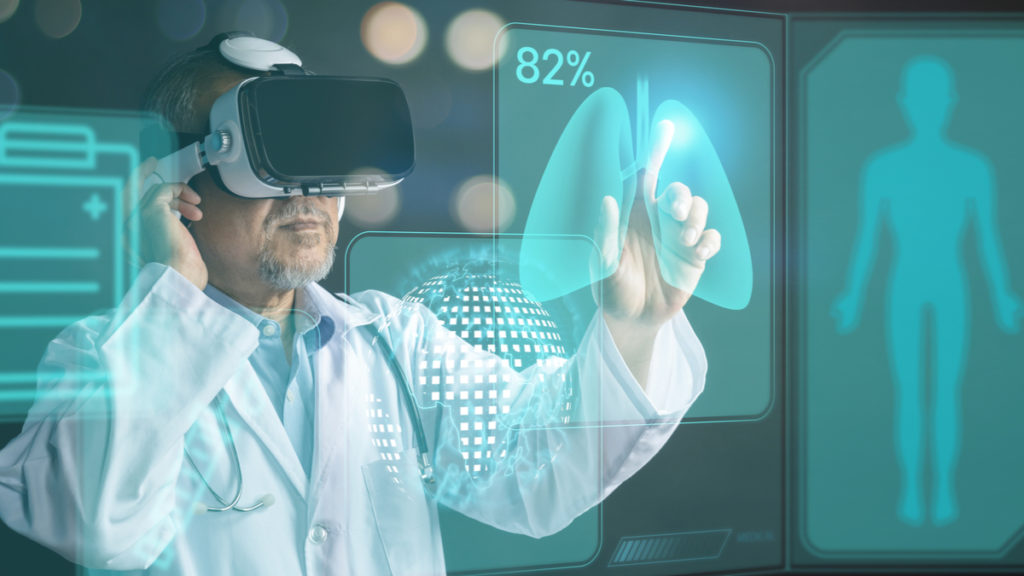Just like the advent of telemedicine and mobile device integration in the past, the metaverse stands to be a massive technological gamechanger for healthcare in 2022.
As a combination of leveraging virtual reality (VR) and augmented reality (AR) technology operate in virtual spaces, the metaverse’s potential is staggering: From improved surgical precision, therapeutic usages, social-distancing accommodations, and more, all signs point to widespread adoption of the metaverse as a disruptive transformation in healthcare.
Nevertheless, with these improvements also comes distinct challenges that will redefine modern healthcare as we know it. From achieving seamless integration across existing medical infrastructure, offsetting startup costs, and data security/privacy issues, the metaverse represents a paradigm shift in healthcare that stakeholders must be aware of.
The help you see the impact that the metaverse will have on healthcare as a whole, let’s look at the opportunities and the pitfalls of this technology that are already making their mark in healthcare, including:
- Benefits of the Metaverse in Healthcare and Patient Care
- Virtual Reality’s Growing Role in Medical Training
- Digital Therapeutic Applications of the metaverse
- Augmented Reality in Surgical Procedures
- How Radiology Can Benefit from the metaverse
- Using Medical Wearables in the metaverse
- Challenges of Adoption/Integration of the Metaverse in Healthcare and Patient Care
- Attracting an Audience for the metaverse
- New HIPAA Guidelines
- Privacy & Security Concerns in the metaverse
- Interoperability Issues
- High Cost of Technology
- New Business Models for All Stakeholders
Before we cover these topics, let’s first define what the metaverse is.
What is the Metaverse?
Developed for years by the gaming industry and organizations like Facebook (now Meta), the metaverse is an AR/VR interface where users are immersed in visual, auditory, and haptic sensors to meet other users within a virtually-augmented world. The metaverse can be augmented with Web 3 standards like blockchain to facilitate ownership, online payments, traceability, and more.
Users perform virtual activities in the metaverse that provide real experiences and results in the real world, leading to a number of applications that are redefining how we communicate (in much the same way that the Internet and smartphones have).
At first glance, Meta’s idea of a metaverse seems to be a technology that will be geared towards gaming and entertainment – however, the widespread adoption of AR/VR tech in industries such as architecture, manufacturing, and supercomputing has proved it a viable technology for the demands of healthcare.
As the metaverse continues to evolve and be widely adopted in healthcare settings, expect this technology to provide new directions to healthcare that encompasses:
- Artificial Intelligence (AI)
- Virtual Reality (VR)
- Augmented Reality (AR)
- Extended Reality (XR)
- Internet of Medical Devices
- Web 3.0
- Intelligent cloud
- Edge computing
- Robotics
- And more
Benefits of the Metaverse in Healthcare and Patient Care
Virtual Reality’s Growing Role in Medical Training
The Metaverse’s user-immersion aspects are a perfect vehicle to train medical staff. Here are a few directions the Metaverse is heading for medical training:
- Simulation training, such as trainees getting an up-close view of a surgeon’s procedure enhanced with tactile haptic controls
- Exams can be verified from video recordings of practice procedures
- Interactive training modules that enhance learning key concepts where, for example, VR can take a learner within the human body and can provide a 360° view of a patient’s ailment.
Digital Therapeutic Applications of The Metaverse
The Metaverse is already showing signs of new opportunities in therapeutic applications. Digital therapeutics are seeing rapid adoption of this form of therapy, where VR and AR tech in the metaverse enables applications such as cognitive therapy, support groups, psychiatric evaluations, rehabilitation, and – with the support of haptic sensors – even physical therapy.
Accelerated by the COVID-19 pandemic, expect digital therapeutics that bridge the gap between the physical and digital with real-world results. For example, nurses can meet patients in the Metaverse aided with remote monitoring to help perform daily checkups and discussions.
Augmented Reality in Surgical Procedures
With surgical procedures already making use of advanced tech like robotics, the Metaverse is expected to be an effective tool to help perform complicated surgical procedures and enhance patient care.
In nearly every facet of surgery, the Metaverse has already generated plenty of hype and projections about its capabilities:
- Surgeons will meet in a virtual operating theater to collaborate together in surgery with assistance from other consultants and specialists
- Surgeons will have a display of a patient’s body vital signs, images, medical history, and other types of relevant patient data
- New integrated technology with the Metaverse can perform provide rapid test results in real-time for better patient outcomes
- And more
Obviously, adoption will be slow initially, as clinical trials must be performed to ultimately evaluate the Metaverse as a practical part of surgery. As with integrating robot-assisted surgery, expect the Metaverse to become more and more top-of-mind as it grows in usage.
How Radiology Can Benefit From The Metaverse
Radiology imaging is one department in healthcare that will obviously benefit with the metaverse’s immersive visual capabilities, unleashing new capabilities in radiology, including:
- Greater image visualization and manipulation
- View dynamic images with more details for a better diagnosis of disease/injury
- Facilitates close collaboration between physicians on medical images in a 3D format
Using Medical Wearables In The Metaverse
Metaverse will empower the usage of medical wearables for patients and physicians. Devices, such as COPD monitors, can alert emergency staff and caregivers to provide wellness checks if a patient has a COPD flare-up, for example.
Wearables are also projected to equip physicians with better data, enhancing virtual appointments in the Metaverse with real-time and collected data.
Challenges Of The Metaverse In Healthcare And Patient Care
Attracting an Audience for the Metaverse
How will Meta and other tech companies attract people to the metaverse? For any new technology, gaining market traction is up to its users.
This raises many questions about trust and usability of the metaverse. For example, would the elderly and less-tech-savvy enter the metaverse and get the best care? Or, would metaverse appointments be perceived as just as valuable as in-person visits?
New HIPAA Guidelines
One obstacle for adopting the metaverse will be ensuring that patients’ confidential information (including PHI/ePHI) is safe and secure. HIPAA guidelines have evolved with the proliferation of telehealth and mobile device integration, so lawmakers will need to update guidelines that accommodate the wealth of information that the metaverse provides.
Privacy & Security Concerns in the Metaverse
Another challenge is the security of patient data in the metaverse. Healthcare is often targeted by cybercriminals as a high-value and susceptible target, so incorporating the metaverse into healthcare introduces a new realm of issues that must be dealt with.
Furthermore, privacy is always a concern with greater amounts of patient data. Whether patients feel at ease to communicate and interact with the metaverse remains to be seen on a mass scale; however, initial results prove promising
Interoperability Issues
Interoperability is a key component of today’s healthcare paradigm – and one of the most challenging when it comes to emerging technologies. Adding yet another element like the metaverse can have drastic and unpredictable effects on which devices are easy to port among different platforms and networks. Unless the entire healthcare industry quickly evolves data and communication standards, the adoption of the metaverse will be slow and may even lead to some negative results.
High Cost of Technology
To enable the full potential of the metaverse in healthcare, it requires massive infrastructure to function. From uninterrupted 5G to high-tech hardware (like glasses, sensors, and other wearables), the startup may be out of reach for many physicians and hospitals.
This also reflects on the patients, which may require equipment to adhere to prescribed treatments and oversight. Would insurers be willing to pay for devices to access the metaverse – or would patients be on the hook for this expense?
New Business Models for All Stakeholders
All healthcare companies will need to create a new business model to incorporate the metaverse to remain viable. Here’s just a few items to consider about how disruptive the metaverse will be to healthcare:
- Insurers may choose to compensate virtual health visits in a different manner than as in-person visits
- Malpractice lawsuits may require recording of time spent in the metaverse for liability purposes
- Commercial payers will need to have special medical codes for metaverse-specific sessions
- Software vendors will need to make their software and related devices compatible with the metaverse
- There will need to be serious debate about whether physicians can prescribe medication and/or treatments virtually
* * *
In conclusion, the metaverse is emerging as an immersive technology with big potential for optimizing patient care across the entire healthcare spectrum.
Nevertheless, there will be challenges that will motivate stakeholders to pay close attention to the many new shifting dimensions of the metaverse. By anticipating these potential pitfalls, healthcare will create better expectations for this immersive (and unprecedented) technology.
Want to compete in the Metaverse? Subscribe to the My Metaverse Minute Channel:







